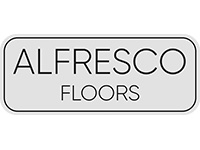Composite decking is becoming one of the most common materials used on balcony flooring and other external projects, and for good reason.
Not only does it provide a timber aesthetic that is highly sought after by architects, specifiers and end-users alike, it also has a host of features to stand it apart from alternatives on the market. Things like slip resistance, being rot & damp proof, and cool underfoot are all ticks in the boxes that the end-user is looking for.
In addition, some composite decking is Class A fire rated – although it’s important to note that most varieties are not even B-rated, and it’s crucial to understand the properties of your selected material.
With composites being such a sound material to use on your decking projects, it begs the wider question, ‘where can they be used?’
Here, Alfresco explores the latest fire regulations and how this guides the places where you can use composite decking.
WHAT ARE THE LATEST FIRE & BUILDING REGULATIONS?
Specifying correctly to meet fire regulations is essential.
Following Grenfell and the subsequent Hackitt Review, a new Building Safety Bill was introduced, helping to mitigate the risk and potential of another tragic disaster.
In summary, it states that specified attachments (balconies) on buildings over 18 metres (11 metres in Scotland) must use Class-A rated materials. And increasingly, many new and refurbishment projects are specifying Class-A rated as standard even if it is not required by the Building Regulations.
On top of the Building Safety Bill, the Fire Safety Act introduced in 2021 is added protection for residential buildings and their occupants, as it places responsibility on those in charge of the development and construction.
USING COMPOSITE DECKING ON BALCONIES
Essentially, the above means that composite decking could be used on specified attachments and balconies, but it’s not quite as straightforward as that.
While options such as ZERODECK, manufactured from mineral composites, are Class A1 fire rated and meet the requirements of the Building Safety Bill and The Fire Safety Act, other composites do not.
It’s important to understand the elements used in the manufacture of your composite decking as not all options are Class A-rated, or even B-rated. Most composite decking options contain plastic and wood fibres which mean it is highly unlikely they will comply.
If your composite is Class-A fire rated, the reality is, there are no limits to where you can use it as long as it fits the brief and meets the regulations; suitable for balconies, courtyards, communal areas, outdoor dining areas and residential gardens, composite decking is extremely versatile.
If you are an architect or specifier, it’s crucial that you seek the appropriate test certificates for the products used on your development.
INSTALLING COMPOSITE DECKING
Fire rating isn’t the only factor in deciding where composite decking can be used, the installation methods offer different opportunities too.
Many composite decking options, ZERODECK included, provide a choice of installation methods. One option is clip fixed. In this option, the deck is clipped to the joist directly negating the need for surface mounted fixings and providing a clean finish.
Depending on where you are installing and what aesthetic you are after, these installation methods provide a wider range of options to you.
Ultimately, whichever method you are using, if you are using your composite as part of an A-rated scheme, it is essential to use a sub-frame that is also A-rated. Alfresco Floors provide a number of fully A-rated products that are compatible with ZERODECK and other A-rated finishes.
USING COMPOSITE DECKING ON YOUR NEXT PROJECT
It all boils down to the fire and building regulations. If composite decking meets the requirements and is what needs to be specified on your next project, then it can be used anywhere; from residential, to commercial and public spaces.
Despite this, a lot comes down to the particular construction of the composite decking. While options like ZERODECK are Class-A fire rated, many others are not and include wood and plastic, meaning they are highly likely to be combustible.
Understanding the latest regulations and the materials making up your composite decking is crucial in determining where and when to use it.
To find out more visit www.alfrescofloors.com.
Where Can You Use Composite Decking?
| T | 020 8977 0904 |
|---|---|
| 020 89770904 Tech Dept. | |
| E | info@alfrescofloors.co.uk |
| W | Visit Alfresco Floors's website |
| Alfresco's E-Book | |
| Unit 6, Teddington Business Park, Station Road, Teddington, Middlesex, TW11 9BQ |


